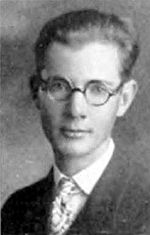Fred Lawrence Whipple
Fred Lawrence Whipple | |
|---|---|
 Fred Lawrence Whipple at age 95 in 2001 or 2002 | |
| Born | November 5, 1906 |
| Died | August 30, 2004 (aged 97) |
| Nationality | American |
| Known for | Composition of comets, Whipple shield |
| Awards | |
| Scientific career | |
| Fields | Astronomy |
| Institutions | Harvard College Observatory |
| 1252 Celestia | 19 February 1933 | list |
Fred Lawrence Whipple (November 5, 1906 – August 30, 2004) was an American
Life

Whipple was born on November 5, 1906, in
After taking a class in astronomy, he enrolled at the University of California, Berkeley where he obtained his PhD in Astronomy in 1931. While in graduate school, he helped map the orbit of the then newly discovered dwarf planet Pluto. He joined Harvard College Observatory in 1931 and studied the trajectories of meteors, confirming that they originated within the Solar System rather than from interstellar space. In 1933, he discovered the periodic comet 36P/Whipple and the asteroid 1252 Celestia. He also discovered or co-discovered five other non-periodic comets, the first of which was C/1932 P1 Peltier-Whipple, independently discovered by the famed amateur astronomer Leslie Peltier, while his last, and brighter, was C/1942 X1 (Whipple–Fedtke–Tevzadze).
During
From 1950 until 1977 he was a professor of Astronomy at
Whipple made at least one media appearance, in the science documentary film Target...Earth? (1980). He also appeared in the BBC's coverage of the Giotto encounter with Halley's Comet, in 1986.
Whipple died in 2004, aged 97.
Honors
Awards
- President's Award for Distinguished Federal Civilian Service, by US President John F. Kennedy (1963)
- Meteoritical Society(1970)
- Golden Plate Award of the American Academy of Achievement (1981)[8]
- Gold Medal of the Royal Astronomical Society (1983)
- Bruce Medal of the Astronomical Society of the Pacific (1986)
- Henry Norris Russell Lectureship of the American Astronomical Society (1987)
- Whipple Award of the American Geophysical Union (1990)
Honors
- Elected to the American Academy of Arts and Sciences (1941)[9]
- Elected to the American Philosophical Society (1956)[10]
- Elected to the United States National Academy of Sciences (1959)[11]
Named after him
- Main-belt asteroid 1940 Whipple[12]
- Whipple Observatory on Mount Hopkins in Arizona
- Whipple shield
- Whipple House on Great Camanoe in the British Virgin Islands (not to be confused with the John Whipple House, in Ipswich, Massachusetts).
References
- ^ "Minor Planet Discoverers (by number)". Minor Planet Center. 4 September 2016. Retrieved 25 September 2016.
- .
- ^
Whipple, Fred L. (1950). "A Comet Model. I. The acceleration of Comet Encke". doi:10.1086/145272.
- ^
Whipple, Fred L. (1951). "A Comet Model. II. Physical Relations for Comets and Meteors". doi:10.1086/145416.
- ^
Whipple, Fred L. (1955). "A Comet Model. III. The Zodiacal Light". doi:10.1086/146040.
- ^
Keller, Horst Uwe; Küppers, M; et al. (2005). "Deep Impact Observations by OSIRIS Onboard the Rosetta Spacecraft". S2CID 28032857.
- Harvard & Smithsonian. Retrieved 2016-08-14.
- American Academy of Achievement.
- ^ "Fred Lawrence Whipple". American Academy of Arts & Sciences. Retrieved 2023-01-11.
- ^ "APS Member History". search.amphilsoc.org. Retrieved 2023-01-11.
- ^ "Fred L. Whipple". www.nasonline.org. Retrieved 2023-01-11.
- ISBN 978-3-540-00238-3.
Further reading
- .
External links
- Fred L. Whipple at Library of Congress, with 13 library catalog records
- Bruce Medal entry with picture Archived 2016-10-12 at the Wayback Machine
- "Dr. Comet", 2002 CNN article
- Report of his death (BBC)
- Astronomy.com obituary
- Center for Astrophysics | Harvard & Smithsonian press release
- Londoner's WWII diary, 6 Feb 1943, observing Whipple's comet
- F. L. Whipple Oral History Interview from the Smithsonian Institution Archives
- George Field, "Fred Whipple", Biographical Memoirs of the National Academy of Sciences (2007)
- Fred Lawrence Whipple Collection, The University of Alabama in Huntsville Archives and Special Collections
